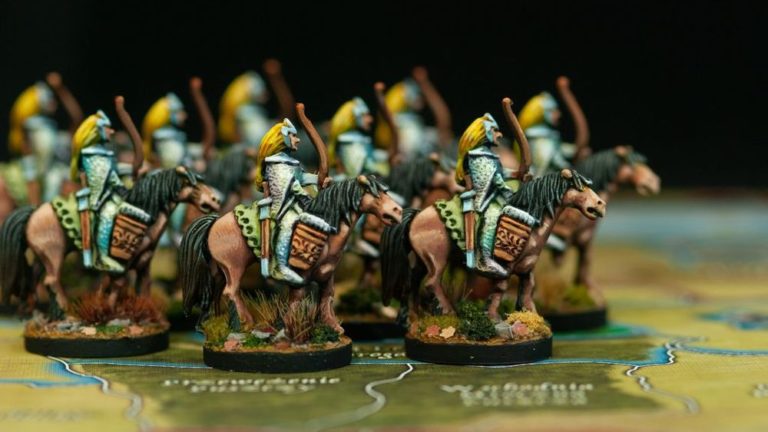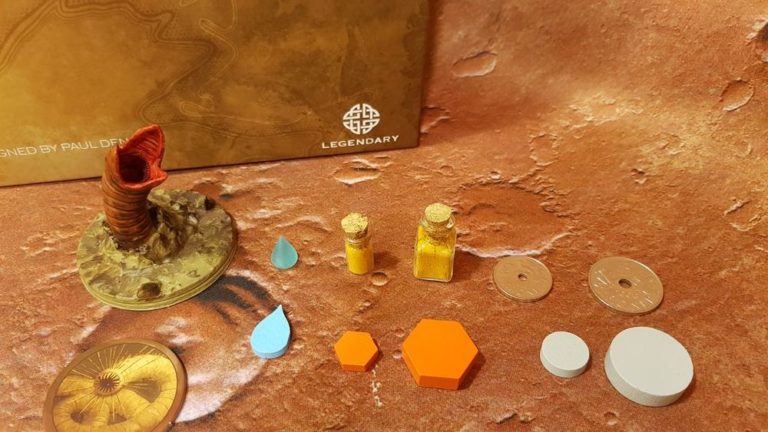The Castles Of Burgundy Review – In-Depth Analysis
The Castles Of Burgundy Review – In-Depth Analysis
Imagine a tapestry woven from rich strategy, historical allure, and the captivating challenge of building a principality. The Castles of Burgundy is a gem in the landscape of board games, one that has gathered accolades and a dedicated following. In this The Castles of Burgundy review, I’m thrilled to share with you the nuanced layers that make this game a staple on my shelf. From the strategic depth to the tile placement intrigue, each session unfolds like a new chapter in a personal epic of conquest and cunning.
Key Points:
- The Castles of Burgundy is a strategic board game set in medieval Burgundy.
- It offers a blend of chance and strategy, combining dice rolling with tile placement.
- The game allows for diverse strategies and paths to victory.
- The historical theme and visual design contribute to the immersive experience.
- The game is accessible for newcomers but offers depth and complexity for seasoned gamers.
- It is praised for its replayability and has expansion content available.
- The game is adaptable to various player counts and has different dynamics for two players versus three to four players.
Navigating through vineyards and trading routes, each player vies for dominance, constructing their own estate in medieval Burgundy. I remember the first time I introduced the game to my circle of friends; the initial furrowed brows in contemplation quickly turned into expressions of delight and anticipation as they began to see their realms take shape. Through this review, I intend to convey not just the mechanics and aesthetics of the game but the soul that beats beneath its surface – the compelling invitation to step into a role of baronial oversight and shrewd planning.
But it’s not just about the competitive edge; it’s also about the camaraderie and stories that emerge around this game’s table. The Castles of Burgundy cultivates a rich soil in which strategy and serendipity grow side by side, resulting in a harvest of unforgettable gaming experiences. Join me as we delve into the heart of this masterpiece and uncover the reasons it has earned its lofty reputation among board game enthusiasts.
The Essence of The Castles of Burgundy
At the heart of The Castles of Burgundy lies a blend of chance and strategy that compels players to adapt and overcome. This game intricately combines the randomness of dice with the strategic freedom of tile placement, demanding players balance their grand plans with the whims of fate. As someone who values both strategy and the thrill of a lucky roll, I find this game hits a sweet spot, offering a palatable challenge that keeps me coming back.
What Makes The Castles of Burgundy Stand Out?
There’s something about The Castles of Burgundy that gives it a distinctive edge within the myriad of board games out there. First, it’s the satisfying crunch of a placement point salad game, a characteristic that has intrigued my strategic senses since I first rolled the dice in Burgundy’s lands. It’s not just about placing a tile; it’s about weaving a tapestry of castles, knowledge, trade, and livestock to create a kingdom that stands the test of time – and competition.
The second standout feature is the strategy needed to wield dice rolls to your advantage. Even a cursory dive into The Castles of Burgundy highlights the delicate balance between luck and planning. I can’t help but admire the way you can mitigate dice unpredictability with carefully hoarded worker tokens, shaping the odds in your favor, or altering plans on the fly to seize opportunity from the claws of misfortune. This delicate dance of strategy and adaptation has led to some of the most memorable gaming moments for me and my friends.
Lastly, there is a diverse set of strategies available to players. Whether you’re the kind of player who meticulously plots every move or thrives on adapting to the changing tides of fate, this game offers a place for every style. I’ve seen games where a seemingly quiet strategy of scholarly pursuit has sprung a surprise victory, and ones where a friend methodically built towards their win one tile at a time against all odds. It’s this very plurality of paths to victory that makes each play-through a fresh and exhilarating puzzle to solve.
The Castles of Burgundy offers a satisfying placement point salad game with a delicate balance between luck and strategy, and a diverse set of strategies available to players.
The Historical Context and Theme
The verdant valleys and rolling hills of medieval Burgundy offer more than just a backdrop for the game – they represent a time when nobles engaged in a silent war of expansion and ambition. The Castles of Burgundy envelops its players in this historic theme, asking them to step into the shoes of aristocrats who must strategically develop their estates to gain influence and wealth.
It’s not every day that a game manages to capture a sense of bygone grandeur while still keeping players rooted in the ebb and flow of measured strategy and placement decisions. Every time I’ve unfurled the game board, I’ve been transported to a time where every tile placement feels like a decree being passed or a castle being erected on the horizon. This thematic resonance not only enriches the gameplay but also provides a narrative framework that transforms a series of turns into a storied competition for historical legacy.
Core Mechanics and Gameplay
Central to the appeal of The Castles of Burgundy is the lean, yet layered, mechanics governing the game. Players find themselves intricately weaving a tapestry of actions, from tile procurement to strategic placement, with each choice offering a branching path to potential victory. This core gameplay loop encapsulates the essential delight of Euro-style board games – each decision is a drop in the pond, creating ripples that extend far beyond the initial point of contact.
The Role of Dice in Strategy and Planning
Dice might conjure thoughts of pure chance, but within The Castles of Burgundy, they are tools of destiny, shaped and wielded with finesse. Each roll isn’t simply about luck – it’s the start of a tactical dance. As a game that prides itself on its strategic dimensions, player choices in mitigating these rolls through workers – essentially, the peasantry of your burgeoning estate – become pivotal. Imagine the satisfaction of converting a seemingly unusable roll into the perfect move that completes a coveted region in your estate.
At the start of each round, the anticipation reaches a crescendo – an unpredictable future lies in the palm of your hand, literally. The dice tumble and fate casts its die. Do the numbers align with your grand strategy, or is it time to visit the workers’ quarters? I remember one particularly close game where my last-ditch use of workers dramatically altered my roll, allowing me to place the final tile that clinched my victory. Moments like these are the essence of the game’s charm, where chance and agency collide.
Moreover, the dual-use of dice in both acquiring tiles from the central board and placing them into your estate means your strategic planning is twofold. I’ve seen players agonize over whether to spend their workers to alter a dice roll for acquisition or reserve them for a crucial placement. Balancing these decisions is like walking a tightrope, where calculation and foresight lead to the thrill of a perfectly executed plan.
Tile Placement and Area Control Dynamics
As you delve into the nuances of The Castles of Burgundy, the tile placement mechanic blossoms into a strategic battlefield. Deciding where to place each tile is much like choosing where to build a castle – each decision carries weight and can echo throughout the territory. With every tile that nestles into your principality, a narrative unfold – a monastery here, a mine there, all contributing to the bigger picture of your dominion.
The area control dynamics present an absorbing puzzle. A pasture here could mean a booming livestock trade; a well-placed knowledge tile may unlock a powerful ongoing effect. Early on in my experience with the game, I placed a seemingly innocuous tile that later became the cornerstone of a bustling commercial hub in my estate. It’s bizarrely gratifying how a simple hexagonal piece of cardboard can lead to a swelling sense of pride as you watch your realm evolve turn by turn.
Then there’s the subtle yet potent player interaction. The Castles of Burgundy refrains from direct confrontation but instead promotes a stealthy tug-of-war. Competing for crucial tiles in the central board’s marketplace becomes a silent declaration of intent, a statement that resonates with all players at the table. The sophisticated player will quickly realize that timing and opportunism are just as important as the grand scheme. I can recall the waves of elation when I staved off a competitor by swooping in for a tile they had been eyeing – a benign form of conquest that’s no less satisfying.
The tile placement in The Castles of Burgundy is a strategic battlefield, with each decision carrying weight and contributing to the bigger picture of your dominion.
Components and Aesthetics
Embarking upon a session of The Castles of Burgundy invites players to indulge in a tableau where intricate components and muted aesthetics coalesce to embody the theme of the game. As much as the gameplay, these elements contribute to the full experience, serving not only to charm the senses but also to facilitate the cognitive aspects of play.
Evaluating the Quality of Game Materials
One cannot examine the tactile pleasure of The Castles of Burgundy without appreciating the understated elegance of its components. Each die feels weighty and substantial – a small but poignant reminder that fate is literally in your hands. The tiles, with their snug fit and satisfyingclack as they settle into place, evoke the permanence of building one’s legacy. Yet, the quality of materials has been a dividing point among players; some find the simplicity charming, while others desire more visual and tactile opulence.
As a seasoned gamer, I value durability and functionality. In this game, the tiles have endured countless playthroughs, still boasting crisp edges and unfaded colors. While it’s true that more recent editions, like the lavish special edition, have upped the ante with higher-quality materials, I find the original game’s components strike an admirable balance between unpretentious functionality and satisfactory haptic feedback.
Visual Design and Its Impact on Gameplay
In many ways, the visual design of The Castles of Burgundy mirrors the game’s strategic depth – unassuming at first glance but layered with significance. The earthy color palette and iconography, often criticized for blandness, actually convey a thematic coherence that respects the historical context. Indeed, it’s not the vibrancy of the artwork that grabs you; it’s the way each symbol on a tile conveys its utility with clarity – a boon for strategic planning.
Nevertheless, I must confess that immersion can be somewhat hampered by a design that lacks visual dynamism. I recall moments of longing for the pastoral beauty of Burgundy to be more vividly illustrated upon my table. The balancing act between aesthetic appeal and game mechanics is tricky; the visual design of The Castles of Burgundy, while efficient, may for some be an acquired taste. Yet for those who value substance over style, the visuals effectively recede, letting the elegance of the game’s mechanisms shine unobstructed.

The Learning Curve
Mastering The Castles of Burgundy involves traversing a learning curve that is as inviting as it is deceptive. Its ruleset appears straightforward – a merit that attracts newcomers to the fold. Yet beneath this simplicity lies a deep reservoir of strategy and choice, retaining the satisfaction of veterans and strategists.
Accessibility for Newcomers
The welcoming embrace of The Castles of Burgundy extends a hand to newcomers, offering a ruleset that, though dense, is structured with an intuitive clarity. The first few rounds serve as a gentle introduction, each turn a part of the learning process. Remember, the most daunting aspect for beginners can be the array of icons, but once the symbols become familiar, they transform from a hurdle into a second language – a lexicon of potential.
My own initiation into this game was marked by a sense of empowerment as the logic of the game unfurled before me. Players unfamiliar with placement point salad games will find their strategic muscles exercised, toned by decisions that are rewarding and laden with placement significance. Teachability is one of the game’s quiet strengths, and fostering accessibility without sacrificing depth is a design triumph that’s worth lauding.
The game of The Castles of Burgundy offers a welcoming and intuitive learning experience, transforming initial complexity into a rewarding and empowering strategic challenge.
Depth and Complexity for Seasoned Gamers
For the experienced gamer, The Castles of Burgundy presents a strategic banquet – the kind that keeps the mind whirring long after the last tile is placed. With each game comes a subtle shift in the winds of chance and choice, ensuring that the path to victory is never predetermined but carved anew from a landscape rich with possibilities. Each player’s board is a unique puzzle, demanding a custom approach tailored to its evolving needs.
The depth is further amplified by the strategic diversity on offer. Will you focus on optimizing your estate’s agricultural output, or will you diversify with trade and scholarly endeavors? Seasoned players come to treasure the nuanced layers of strategy and tactical adaptation required to navigate the game. And then there are those who, much like myself, take pleasure in the subtle intricacies of tile placement and the area control dynamics that transform the game into an engaging cerebral contest.
It’s not just about what you build; it’s also about what you withhold and when you strike. A delayed placement can prove as powerful as an early land grab. The sagacious gamer learns to read not only the board but also the tendencies and tactics of their adversaries. Often, I’ve found some of the most pivotal moments to reside in these quiet standoffs, where foresight and cunning dictate the shifting balance of power.

The Castles of Burgundy Across Different Player Counts
The Castles of Burgundy adapts with grace to various player counts, each configuration offering a distinctive rhythm and strategic emphasis. The dynamics between two dueling estates differ significantly from the multifaceted politics of a four-player game, where the board becomes a more crowded and competitive place. Whether navigating an intimate duel or a bustling field of contenders, the game accommodates with elegance, ensuring that the core experience remains engaging irrespective of the number of participants.
Best Practices for Two Players
Ah, the duet of decision-making that is The Castles of Burgundy for two players – it’s akin to a well-orchestrated symphony! Now, based on musings and experiences from friends and personal play-throughs, when you’re playing with just another soul, it’s all about efficiency and anticipation. Keep a keen eye on your opponent’s estate; a strategic snipe of a tile they need could swing the momentum your way. And remember, with fewer players, the odds you’ll roll what you need increase, so this is where your flexibility shines. However, don’t solely rely on the roll of the dice; those worker tiles are your ace in the hole. Your mantra here: flexibility and foresight.
The two-player game affords you a peculiar intimacy with your opponent’s strategies that larger groups tend to water down. This is where tony mastrangeli moments of wit can make all the difference. Count your opponent’s remaining workers. Note the resources left on the board. The fewer players there are, the more surgical you can get with your moves. Burgundy becomes less about the roll of the dice and more about the dance with your rival – a cerebral ballet that dances on the knife-edge of cooperative competition.
Scaling Up: The Game with Three to Four Players
Introduce more players to the fields of Burgundy, and the dynamics shift like the tides! Three to four players create a more congested marketplace, increasing the competition for those pivotal tiles. Here, you can’t bank on the dice falling your way; instead, adopt a mindset of adaptability. With more people, the game weaves a richer tapestry of interaction and unpredictability. Reevaluate your strategies frequently and be prepared to pivot. Flexibility in your game plan is non-negotiable; you’re now playing against multiple sets of intentions, and the ability to roll with the punches – quite literally – is paramount.
Engage with the group as a collective adversary. Whereas in a two-player game, you could afford to be reactive, a larger group pits you in a race against several fronts. It heightens the drive for strategic land grabs and changing tactics mid-stream. Each player adds another layer to the strategy of Burgundy, and with it, the beauty of the game’s complexity blossoms. You’ll learn to appreciate the nuances of play that larger groups afford, embracing the chaos and riding the wave of collective decision-making. Games at this player count become rich with diplomatic nudges and less visible, yet deeply impactful, moves.
Replayability and Expansion Content
Replayability is the cornerstone of any great board game, and The Castles of Burgundy stands as a testament to that. With its intricate web of strategies and ever-changing gameplay, no two games feel the same. And if the base game ever starts to feel a tad too familiar, there’s always the siren call of expansion content that breathes new life into your Burgundy experience. These expansions often introduce fresh mechanics and strategy nuances that keep veteran players on their toes, ensuring The Castles of Burgundy remains a stalwart resident on game shelves.
The Base Game’s Longevity
The beauty of The Castles of Burgundy base game is its inherent longevity, an aspect that seasoned players revere and newcomers will come to admire. The modular boards coupled with player choice create a plethora of possibilities that keep the game as invigorating as your first foray into its Burgundy vineyards. Every game has its own narrative, its own challenges to surmount, which makes it a perennial favorite on game nights. The test of time has been kind to The Castles of Burgundy, whose base game still lures players back, time and again, for just one more strategic crusade through medieval landscapes.
Delve deeper into any board game enthusiast’s repertoire, and you’ll find that longevity is not just desirable; it’s the hallmark of quality design. Consider the dynamic nature of player interaction in The Castles of Burgundy; this is what breathes life into the game’s core. It offers a profound understanding that with each roll of the dice and tile placement, you’re not just playing a game – you’re crafting a legacy within the confines of a pastime you adore.

The longevity and dynamic player interaction in The Castles of Burgundy make it a perennial favorite and a hallmark of quality design in the board game world.
Enhancing the Experience with Expansions
But what if I told you there’s more to this beloved game? The Castles of Burgundy expansions act as a new vintage to be savored – an infusion of fresh mechanics and tactical layers that offer flexibility and cater to an ever-evolving player base. These expansions are not seen as extraneous but as extensions that amplify the joy of the game. For those who’ve traversed the rolling green hills and become barons of Burgundy in their own right, the expansions are like the hidden passages of a castle, unveiling new adventures and treasures to the lords and ladies of the land.
Many might argue that expansions can stretch a game thin, but for The Castles of Burgundy, they fit like a glove. They maintain the spirit of the game while enhancing its essence, providing nuanced ways for veterans to rediscover the game they fell in love with. They’re never just add-ons; they’re rejuvenating elixirs that ensure you will roll those dice with the same giddy anticipation as your first venture through the storied games of Burgundy‘s realm.
Comparing Editions
Navigating the different editions of The Castles of Burgundy can be quite the quest; each one has subtle embellishments and nuances that can sway a seasoned player’s experience.
Original vs. Anniversary Edition: What’s New?
Step into the realm of Burgundy anew with the Anniversary Edition, and you’re greeted with a tableau of refreshed artwork and a cornucopia of new boards, offering that much sought-after variety. This edition commemorates The Castles of Burgundy’s storied life with components that pay homage to the journey it has taken since its original inception. Swathes of new tiles ensure that each player feels like a pioneer, charting unknown territories even if they have laid siege to Burgundy’s tracts countless times before.
It’s not just a visual makeover; the Anniversary Edition weaves an intricate new layer into the tapestry that is The Castles of Burgundy, with additional content that richly enhances the base game. And yet, at its core, it stays true to the mechanics and strategies that made the game a modern classic. Players old and new will find something to relish as the essence of the game remains untouched beneath the new splendor – like discovering a long-lost vintage cellar beneath your estate.

Is Upgrading Worth the Investment?
Deciding whether to upgrade to the Anniversary Edition of The Castles of Burgundy is a matter of personal nostalgia and the craving for novelty. For those whose copy is well-worn from years of use, the Anniversary Edition is a love letter to your enduring ardor for the game. The new tiles and game boards are like an echo of laughter from past game nights, a reminder of the player camaraderie and mental acrobatics that The Castles of Burgundy fosters.
Consider the investment in the same light as refurbishing a cherished heirloom – it’s renewing the commitment to a game that has given so much joy. The Anniversary Edition is an opportunity for fresh experiences with a classic, providing just enough familiarity to evoke nostalgia and enough new challenges to wrap players in the warm embrace of newfound excitement. If The Castles of Burgundy holds a special place in your heart, then yes, upgrading is not just an investment; it is a tribute.
Upgrading to the Anniversary Edition of The Castles of Burgundy is an opportunity to renew your commitment to a beloved game and experience fresh challenges while evoking nostalgia.
FAQs
1. What is the optimal number of players for The Castles of Burgundy?
The optimal number of players for The Castles of Burgundy is often considered to be two. This count allows for a quicker pace, deeper strategic planning, and a more intense competition between players.
2. How does The Castles of Burgundy cater to different player skill levels?
The Castles of Burgundy caters to different player skill levels through adjustable strategies that range from straightforward to complex, offering fun and challenge for both novices and experienced gamers alike.
3. Are there any essential expansions for The Castles of Burgundy?
While no expansions for The Castles of Burgundy are deemed essential, many players find that they can add depth and variability to the gameplay, enriching the overall experience.
4. How long does an average game of The Castles of Burgundy take?
An average game of The Castles of Burgundy takes about 30 minutes per player. This can vary with players’ familiarity with the game and individual play styles.
Conclusion
In this dive into The Castles of Burgundy review, the facets of the game unfold like the petals of an intricate rose – one that’s grown heartily in the rich soil of Burgundy. Its beauty lies not only in the mechanics and the thought-provoking challenges it lays before the player, but also in its ability to draw people back to its hallowed vineyards time and time again. Its genius – it caters to a variety of palates, from those who cherish the flexibility in the game’s infinite paths to victory, to newcomers bathing in the glow of a freshly discovered hobby.
Allow me to impart one last nugget of wisdom. While the journey through Burgundy might be filled with competition, the true victory lies in the camaraderie shared, the wits honed, and the memories cast in the amber of good times. The game transcends the sum of its parts, capturing the spirit of nights spent rolling dice, plotting strategies, and savoring the sweet taste of a well-earned win.
So, my friend, I hope this review has been your guiding star in understanding the nuances of this storied game. As we part ways, remember that the world of board games is vast and ever-welcoming. Until we cross paths at a game table once more, may your dice roll true, and your strategies be ever cunning. Farewell, and happy gaming. – Lucas
More Boardgame Reviews:
This article uses material from BoardGameGeek and is licensed under the Creative Commons Attribution-Share Alike License.







